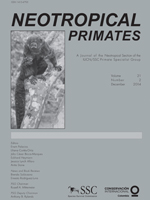Introduction
Together with chimpanzees and baboons, capuchins (Cebus and Sapajus spp.) are the most carnivorous — rather than insectivorous — nonhuman primates (Freese and Oppenheimer, 1981; Rose, 1997). Capuchins are known to feed on a wide range of vertebrate prey, including mammals (Resende et al., 2003; Rose et al., 2003; Cunha et al., 2006; Milano and Monteiro-Filho, 2009; Palmeira and Pianca, 2012; Rodrigues, 2013), and other monkeys (Sampaio and Ferrari, 2005; Carretero-Pinzón et al., 2008). However, while marmosets and tamarins (Callitrichidae) are found throughout most of the geographic range of the capuchins, and are of similar size to the mammalian prey typically captured by these larger monkeys, no predation events involving callitrichids have ever been recorded. The present study reports on the capture of a common marmoset (Callithrix jacchus) by an adult male capuchin at a site in northeastern Brazil. The observed sequence of events indicates concerted group foraging behavior and an ambush type of strategy on the part of the adult male that captured the marmoset.
Methods
The event reported here was observed during fieldwork at the 144 hectare Ibura National Forest (10°51′ S, 37°07′ W) in Nossa Senhora do Socorro, Sergipe, northeastern Brazil, on February 23rd, 2013. The local forest is inhabited by at least eight marmoset (C. jacchus) groups, and a group of capuchins, with five members at the time of the present observation. As a number of confiscated capuchins have been released into the forest in recent years, it is unclear which species are represented in the local population, especially as many of the individuals present pelage more characteristic of Sapajus nigritus or Sapajus libidinosus than Sapajus xanthosternos, the native local species (Rylands et al., 2013). Given this, the members of the capuchin group were classified as Sapajus sp. for the purposes of the present study.
Results
At 06:20 h on February 23rd, 2013, a number of animals — both capuchins and marmosets — were observed moving rapidly within the dense crowns of fruit-bearing mango (Mangifera indica) trees at heights of 10–13 m. Members of both species were emitting intense vocalizations, and eight marmosets were observed moving rapidly on horizontal branches, more dispersed in the lower strata in at least three trees, followed by at least three capuchins, more closely grouped together, with the adult (alpha) male at the front and a female carrying an infant behind. The distribution and movements of the animals indicated that the capuchins were chasing the marmosets.
As the animals approached each other, the alpha male (Sapajus libidinosus morphotype), easily distinguished by its amputated tail (Fig. 1), was observed resting in dense foliage close to the branches along which the marmosets were moving. The capuchin then snatched at an adult marmoset as it passed and captured the monkey in its right hand. As soon as it caught the marmoset, the alpha male moved rapidly out of sight, followed by the other capuchins, which now ignored the marmosets. Although no predation was observed directly, the sequence of events indicates clearly that the capuchin killed and presumably ingested the marmoset. The remaining marmosets continued moving rapidly and vocalizing excitedly for approximately one minute and then also moved away into the forest. The whole sequence of events lasted around 10 minutes.
Figure 1.
Adult male tufted capuchin (Sapajus sp.) responsible for the attack on a marmoset in the Ibura National Forest, Sergipe (Brazil), showing its distinctive tail. Photo: Natasha

The sequence of events observed here indicates that the alpha male capuchin had been waiting in anticipation of an opportunity to ambush a passing marmoset. This contrasts with the behavior of the other capuchins, which were chasing the marmosets actively, although it is unclear whether this represented a purposeful attempt to capture one of these monkeys or to displace them from a food source (mango tree) in a form of interference competition. The alpha male was observed actively attempting to capture marmosets on two other occasions, in April 2013. During each of these events, however, the capuchin pursued the marmosets and attempted to snatch them using both hands, rather than waiting in ambush. While the marmosets often reacted to the presence of the capuchin group with alarm and mobbing vocalizations, and evasive behavior, they were also observed frequently in the vicinity of the capuchins without reacting to their presence, even in feeding trees.
Discussion
The events reported here are not totally unexpected, given the predatory potential of capuchins (Sampaio and Ferrari, 2005; Carretero-Pinzón et al., 2008), although in most cases, it seems likely that the small size and agility of the marmosets may ensure that they avoid predation by other mammals (Ferrari, 2009). Given this, a surprise attack or ambush, as observed in the present study, may normally be the only viable approach for the capture of a marmoset. In the event observed here, even if the behavior of the capuchins did represent a concerted attempted to capture marmoset prey, as proposed by Rose (1997) for Cebus capucinus, it seems unlikely that this represented a coordinated hunting strategy, such as that observed in chimpanzees (Nishida, 1992; Boesch, 1994).
Acknowledgements
We are grateful to IBAMA for authorizing fieldwork at the Ibura National Forest (SISBio: 33930-4), which was supported by CNPq, FAPITEC-SE, CAPES, and the Mohamed bin Zayed Species Conservation Fund (Project: 12055114). We are also grateful to Paulo Cezar Bastos for his support, and all the other Ibura staff for their assistance in the field.





